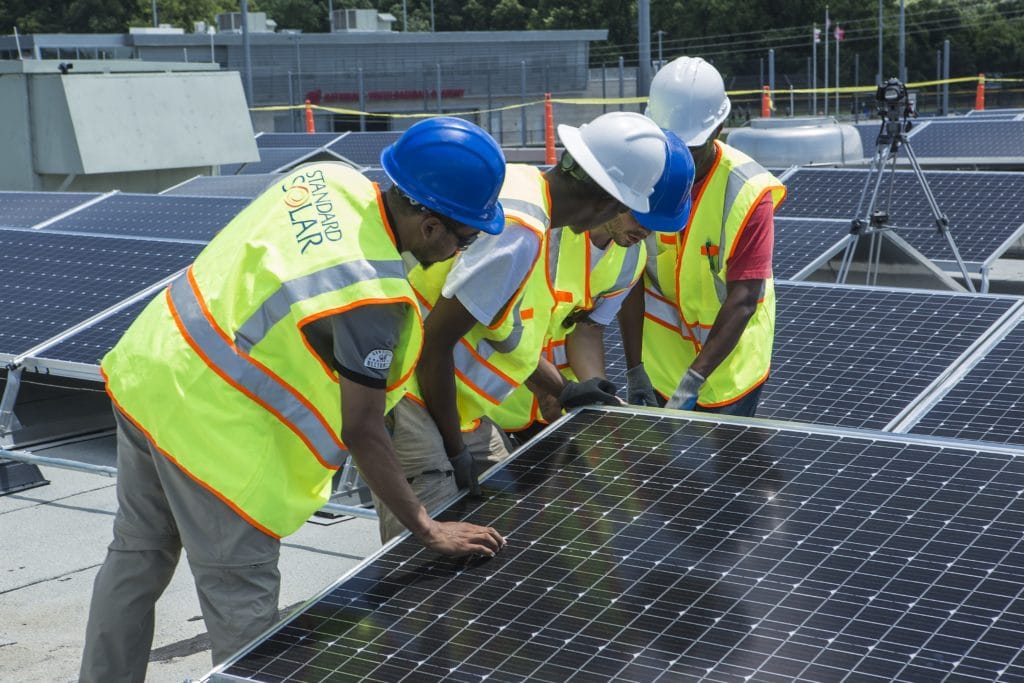The U.S. Department of Energy (DOE) and MSI STEM R&D Consortium announced $5 million in funding to train students for careers in clean energy industries.
The funding will be directed to two minority-serving universities to help train students in the skills needed to succeed in solar and other clean energy careers. MSI Stem R&D is a consortium that partners with more than 60 minority-serving research institutions, industry and government partners, such as DOE.
According to a report by the Interstate Renewable Energy Council (IREC), full-time jobs in the U.S. solar energy and energy storage industries grew in 2022 and demand will only increase in the future. IREC notes that the solar industry expects total U.S. installations will multiply fivefold in the next 10 years, from 141 GW in 2022 to over 700 GW in 2033. SEIA optimistically predicts the total number of solar jobs could more than double, reaching 538,000 by 2032.
The reality, however, is that the tight labor market in the U.S. continues to create hiring challenges. The report notes that in 2022, 44% of solar industry employers said it was “very difficult” to find qualified applicants—the highest such percentage ever recorded in the Solar Jobs Census.
New workforce-related requirements were put into place by the Inflation Reduction Act (IRA) that aims to address training, pay, diversity and job development in underserved areas.
The new initiative driven by DOE in conjunction with MSI Stem R&D supports the Justice40 Initiative that strives to ensure that 40% of the overall benefits of certain federal investments go to disadvantaged communities by helping to build a diverse science, technology, engineering and math (STEM) pipeline to support the transition to clean energy.
“Achieving equitable energy transitions across the country is not possible without a workforce that reflects the diversity of America,” said Susan Hamm, director of the Integrated Strategies Office, EERE. “That’s why DOE provides minority serving institutions with the funding and support they need to educate, develop, and inspire the clean energy workforce of tomorrow. Innovation accelerates when there’s people with a variety of perspectives and backgrounds working together towards a common goal,”
The two universities selected to receive funding for their workforce development projects:
Tennessee State University, Nashville, Tennessee
Tennessee State University’s workforce development program will serve as a pathway to STEM degrees and equip African American, Hispanic and Native American students with the skills needed for entry-level positions in the clean energy sector.
The project will offer an online training using virtual reality coupled with in-person workshops in solar energy (including design, installation, and energy storage). The project also has an entrepreneurship component, encouraging students to develop clean energy businesses to increase the number of clean energy businesses run by minorities.
University of Texas at El Paso, El Paso, Texas
The Hispanic Alliance for Clean Energy Education and Research project aims to train students and build the workforce development capacity in Texas, New Mexico and Puerto Rico. To support workforce development capacity building, six institutions in the Alliance will share expertise and collaborate on research, course materials and jointly mentor junior faculty members. There’s also a plan to expand the project’s reach beyond the six institutions to promote a growing workforce for the clean energy transition.
For more details on EERE’s STEM diversity and workforce development work, visit the Why Clean Energy Matters page.
This content is protected by copyright and may not be reused. If you want to cooperate with us and would like to reuse some of our content, please contact: editors@pv-magazine.com.









By submitting this form you agree to pv magazine using your data for the purposes of publishing your comment.
Your personal data will only be disclosed or otherwise transmitted to third parties for the purposes of spam filtering or if this is necessary for technical maintenance of the website. Any other transfer to third parties will not take place unless this is justified on the basis of applicable data protection regulations or if pv magazine is legally obliged to do so.
You may revoke this consent at any time with effect for the future, in which case your personal data will be deleted immediately. Otherwise, your data will be deleted if pv magazine has processed your request or the purpose of data storage is fulfilled.
Further information on data privacy can be found in our Data Protection Policy.